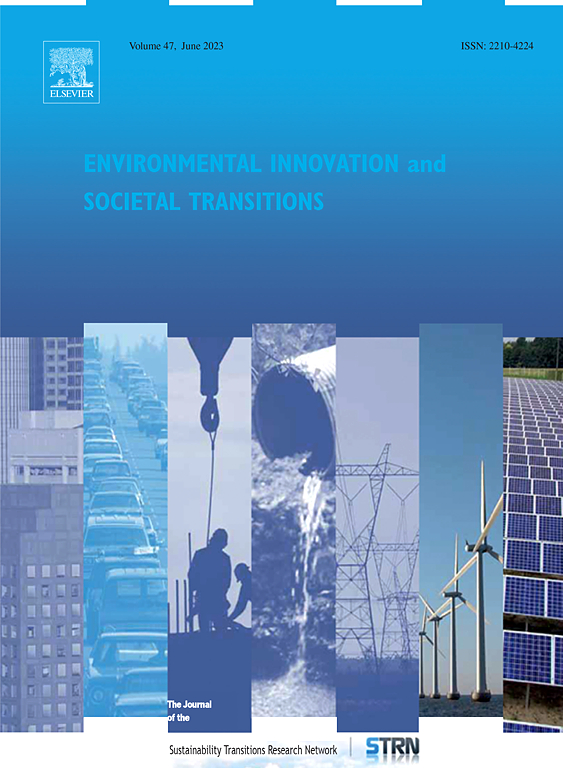Run with the hare and hunt with the hounds: Hybrid technologies' multifaceted role in the transition from incumbent to emerging technologies
IF 5.7
2区 经济学
Q1 ENVIRONMENTAL SCIENCES
Environmental Innovation and Societal Transitions
Pub Date : 2025-04-02
DOI:10.1016/j.eist.2025.100992
引用次数: 0
Abstract
This paper investigates the challenge of using hybrid technologies to accelerate the transition from incumbent to emerging technologies. It delves into the micro-dynamics of technology strategies: exploitation (a passive approach), exploration (a proactive approach), and a balanced exploitation-exploration stance during the transition. Based on technological innovation system (TIS) and Lotka-Volterra models, a system dynamics (SD) technology interaction framework is applied to conventional internal combustion engine vehicles, hybrid electric vehicles, and battery electric vehicles in US market. The SD modelling provides a platform for experimenting with policy mixes by analysing the timing, scale, scope, and sequence of interventions. Several scenarios are explored, such as landscape pressure, predator-prey dynamics, niche- and incumbent-favoured relationships, and sociotechnical transition, spanning from 1985 to a forward-looking 2070. Findings reveal that hybrid technologies play a multifaceted role: as an exploratory solution accelerating technology development dynamics in emerging technologies and as an exploitative solution slowing down market development dynamics in emerging technologies, and hardly inhibiting technology and market development dynamics in incumbent technologies. Moreover, findings confirm the traditional sailing ship effect—establishing a causal link between the emergence of new technologies and the active and systematic enhancement of incumbent technologies—while also uncovering a non-traditional sailing ship effect in the form of ‘spillovers.’ These spillovers enable firms to manage uncertainties and timing in transitions by orchestrating sociotechnical ‘spillbacks’ and ‘spillforwards’ between emerging and incumbent technologies via hybrid technologies. To effectively accelerate transitions using hybrid technologies, the study recommends adopting a sociotechnical policy approach that simultaneously promotes niche creation and regime destabilisation.
与野兔一起奔跑,与猎狗一起狩猎:混合技术在从现有技术到新兴技术的过渡中所扮演的多重角色
本文探讨了利用混合技术加速现有技术向新兴技术过渡所面临的挑战。它深入研究了技术策略的微观动力学:开发(被动方法),勘探(主动方法),以及过渡期间的平衡开发-勘探立场。基于技术创新系统(TIS)和Lotka-Volterra模型,将系统动力学(SD)技术交互框架应用于美国市场的传统内燃机汽车、混合动力汽车和纯电动汽车。可持续发展模型通过分析干预措施的时间、规模、范围和顺序,为试验政策组合提供了一个平台。本文探讨了从1985年到2070年的几种情景,如景观压力、捕食者-猎物动态、生态位和现任者有利的关系以及社会技术转型。研究结果表明,混合技术具有多方面的作用:作为一种探索性解决方案,加速了新兴技术的技术发展动态;作为一种开发性解决方案,减缓了新兴技术的市场发展动态,并且几乎没有抑制现有技术的技术和市场发展动态。此外,研究结果证实了传统帆船效应——在新技术的出现与现有技术的积极和系统的增强之间建立了因果关系——同时也揭示了非传统帆船效应以“溢出效应”的形式存在。这些溢出效应使企业能够通过混合技术协调新兴技术和现有技术之间的社会技术“溢出效应”和“溢出效应”,从而管理转型中的不确定性和时机。为了有效地加速使用混合技术的转型,该研究建议采用一种社会技术政策方法,同时促进利基的创造和政权的不稳定。
本文章由计算机程序翻译,如有差异,请以英文原文为准。
求助全文
约1分钟内获得全文
求助全文
来源期刊

Environmental Innovation and Societal Transitions
Energy-Renewable Energy, Sustainability and the Environment
CiteScore
13.60
自引率
19.40%
发文量
90
审稿时长
56 days
期刊介绍:
Environmental Innovation and Societal Transitions serves as a platform for reporting studies on innovations and socio-economic transitions aimed at fostering an environmentally sustainable economy, thereby addressing structural resource scarcity and environmental challenges, particularly those associated with fossil energy use and climate change. The journal focuses on various forms of innovation, including technological, organizational, economic, institutional, and political, as well as economy-wide and sectoral changes in areas such as energy, transport, agriculture, and water management. It endeavors to tackle complex questions concerning social, economic, behavioral-psychological, and political barriers and opportunities, along with their intricate interactions. With a multidisciplinary approach and methodological openness, the journal welcomes contributions from a wide array of disciplines within the social, environmental, and innovation sciences.
 求助内容:
求助内容: 应助结果提醒方式:
应助结果提醒方式:


